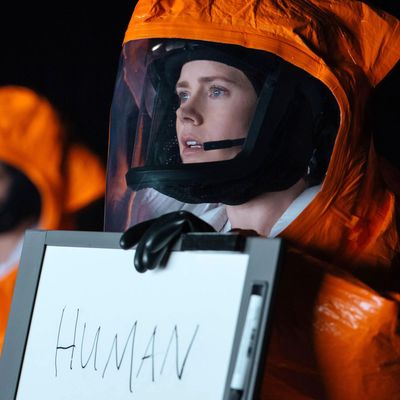
Spoilers for Arrival below.
While there are plenty of praise-worthy aspects to Denis Villeneuve’s brilliant new first-contact movie, Arrival — including, but not limited to, its commentary on the way nations gamify and weaponize science, Villeneuve and director of photography Bradford Young’s gorgeous, gauzy visuals, and a peak Amy Adams performance — the best part is its twist. But the twist is the best part because, like all great twists, it’s not just a surprise ending or some cheap double cross. Instead, in its third act, Arrival does something far greater: In a lovely mirroring of content and form, the film teaches you how to read itself.
Arrival, which is based on Ted Chiang’s short story “Story of Your Life,” is about what happens when a group of 12 alien vessels appear around the world. Louise Banks, played by Amy Adams, is a linguist tasked with asking the aliens why they’re here; Ian Donnelly, played by Jeremy Renner, is a theoretical physicist helping her. To ask that question, Banks must communicate with the aliens, and to do that, she must learn their language, and help them learn hers. This movie is about two things, and the first of them is language.
Language, Banks says, is the cornerstone of civilization. You never understand this better than you do when considering first contact, and with it the galling problem of communication with extraterrestrials. Imagine bridging the space between two cliffs, but those cliffs are in different paintings, hanging feet apart from each other on a wall. You can’t paint outside the borders; instead, you have to figure out a way to paint both within and between them. That’s Banks’s problem. It’s also the movie’s: Apart from a means of interpretation and expression, what does language represent, exactly? Is it a byproduct of the human mind, or, as linguists like Noam Chomsky suggest, integral to the mind itself?
When Arrival breaches this subject first, it sets the stage for its reveal. Donnelly and Banks discuss the idea of whether learning a language can change the way the brain experiences the world. Cut to progress being made on the aliens’ written language, which exists as a circle, an endless loop, rather than a linear sentence. That’s the other thing Arrival is about: time.
Throughout the movie, we’ve been seeing what we believe to be flashbacks, of a daughter Banks had who died of some disease. At first we believe them to be flashbacks, because that’s how the language of film works: When we see footage of another time period intercut among the present, we assume it to be the past. (Our human brains often use the past to illuminate the present.) Banks appears to be a lonely person, dedicated to her job, and so the idea that she lost a child feels neither surprising nor out of place.
But as the end of the film reveals, those aren’t flashbacks at all. They’re memories, for lack of a better term, of the future; a future in which Banks and Donnelly will have a daughter whom they will watch die. Why does she see these visions? Because, as she learns to speak the aliens’ language, she also becomes able to think in the way they do, which, just like their language, is unbound by the linearity of time. (Quantum physics suggests the way we see time is a symptom of our perception anyway, symptomatic in a way language is not.)
Instead of shocking us with fresh data, Arrival’s twist does what the best twists do, including those of The Sixth Sense and The Prestige: Like decoder rings, they show us how to understand what we just watched. From the start, we had the information that Banks gave birth to a child who would die young. We just didn’t know she knew she would do so. The revelation is a bulldozer, confronting us with the brutal nature of our lives, dependent as they are on the unknown. To a species that exists ignorant of the future, such knowledge seems tantamount to death, the end of new experience. What is a life lived at all moments simultaneously? That’s the lives of these aliens, and that’s the bridge Banks creates between us and them. It’s a lovely revelation, heartbreaking in its totality and entrancing in the holes it opens up. The aliens have arrived on Earth to initiate a favor that will pay off 3,000 years in the future. And when Banks tells Donnelly the truth about their daughter, a scene the movie presents to us before we truly know its value, we learn that he can’t handle it, and we don’t blame him.
Banks gives her daughter a palindromic name, Hannah. And in some ways, Arrival is a palindromic film; if the scenes’ order were reversed, it’s easy to see how the movie might still make sense, with the revelations of time and language coming first, with plot and circumstance appearing after. That’s the real twist: It’s all leading toward the same thing.

